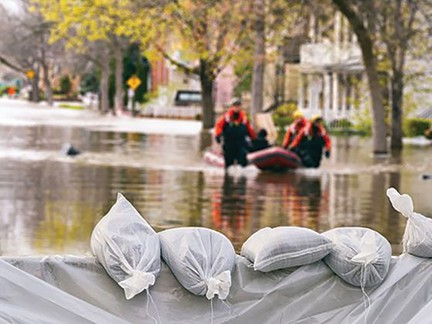By Karl Fippinger, CEM, PMP
From the June 2022 Issue
Communities around the world have experienced devastating impacts from disasters due to a surge in hazardous weather conditions and a changing climate. According to the National Oceanic and Atmospheric Administration (NOAA), by September 2021, the U.S. had experienced 18 major disasters totaling over $104 billion in damages, already eclipsing all of 2020’s total cost. There were 14.5 million homes impacted to some degree by natural hazards, equating to about 1 in 10 homes in 2021, according to a study released by property research organization CoreLogic. With an increasing number of homes and buildings being constructed around the world, emphasis should be placed on leveraging the principles of emergency management for public and private facilities to increase safety and decrease the amount of property damage from disasters.
 Preparing for hazardous events like hurricanes, floods, snowstorms, tornadoes, wildfires, and earthquakes helps communities stay safe, protects the local tax base, ensures continuity of essential services, and supports a more resilient recovery. Using the principles of emergency management can also reduce the fear, anxiety, and losses that accompany disasters. Proactive measures are vital to becoming more resilient to these events, making it important that facility managers understand the Four Phases of Emergency Management and implement a sound strategy for when disaster strikes.
Preparing for hazardous events like hurricanes, floods, snowstorms, tornadoes, wildfires, and earthquakes helps communities stay safe, protects the local tax base, ensures continuity of essential services, and supports a more resilient recovery. Using the principles of emergency management can also reduce the fear, anxiety, and losses that accompany disasters. Proactive measures are vital to becoming more resilient to these events, making it important that facility managers understand the Four Phases of Emergency Management and implement a sound strategy for when disaster strikes.
1. Disaster Mitigation
Disaster Mitigation includes activities aimed at preventing a disaster, reducing the chance of a disaster happening, or reducing the damaging effects of disasters. This is the first step that can be taken to protect employees, residents and visitors from disasters. An easy way for facility managers to take immediate action is by purchasing hazard insurance for properties and ensuring facilities are up to date on the current building safety codes. The Federal Emergency Management Agency (FEMA) recognizes that adopting and enforcing the latest building codes is the best way to mitigate damage from all hazards.
2. Disaster Preparedness
While we cannot always predict what the damage from a natural disaster will be, we can use different tactics, such as a risk assessment, to gauge the actions needed to minimize damage and increase safety.
Facility managers should work to create a comprehensive emergency action plan that everyone in the building contributes to and understands. According to the Occupational Safety and Health Administration, this plan should include a mapped-out evacuation route, special procedures for employees who perform or shut down critical plant operations, systems to account for all employees or residents after evacuation and medical duties for employees who perform them.
Establishing a secure location to take shelter, like a dedicated safe room, is also a vital step for facility managers. A safe room is a potentially life-saving investment that can be retrofit in existing buildings or incorporated into new construction projects. Safe rooms as prescribed by the ICC 500 standard and FEMA P-320 are hardened structures specifically designed to meet specific wind loading criteria and provide near-absolute protection in extreme weather events, including tornadoes and hurricanes. The International Code Council recommends reviewing and updating preparedness plans regularly, especially following any construction project.

3. Disaster Response
Responding to a natural disaster means putting the preparedness plan into action. Response activities occur during and in the immediate aftermath of a disaster. While the effect of every event is different, proper responses focus on the same two things: saving lives and preventing further damage to property. Recommended response activities from the International Code Council include immediate actions like search and rescue, medical care, firefighting, and sheltering. The Disaster Response Alliance is also a great resource to utilize, which consists of a national database of volunteers to assist local, state, or federal entities that need skilled, trained, and certified building safety professionals in the aftermath of a disaster.
During the response phase, the local community’s emergency warning system will provide official statements and emergency alerts, directing residents to proceed in a unified, safe manner. If a facility is still occupied, use the PA System or SMS texts to relay these messages to those still inside. It is extremely important to take these announcements seriously and respond with the utmost caution when dealing with dangerous weather. For example, if you are forced to evacuate, do not return home until authorities announce that it is safe to do so.
4. Recovery From Disaster
Recovering from a natural disaster looks different for every facility and community. The recovery phase of a natural disaster includes actions taken to return to a normal or even safer situation following the disaster. Resources are available for aid, so it is important to understand how and where to access support. Federal assistance programs to aid communities in recovery include FEMA Public Assistance, Hazard Mitigation Assistance, Individual Assistance, and HUD Community Development Block Grants. Additionally, when the facility is properly insured, facility managers will have an easier time financially getting the building up and running again.According to a recent study, 57% of structures including homes, schools, hospitals, and office buildings are located in hazard hotspots and 1.5 million buildings lie in hotspots for two or more hazards. As these hotspots grow increasingly dangerous due to the changing climate, facility managers have significant reason to adapt to the current trajectory by incorporating the Four Phases of Emergency Management into plans for their structures and continuously update them when needed. For the safety of civilians and to avoid potential property damages, these actions present facility managers the opportunity to avoid significant loss.
 Fippinger, CEM, PMP, is the Vice President, Fire and Disaster Mitigation for the International Code Council’s Government Relations Department, where he leads the Code Council’s national fire service and emergency management activities. Fippinger brings more than 30 years of domain experience, having served as an assistant fire chief with the Occoquan-Woodbridge-Lorton Volunteer Fire Department in Prince William County, VA, and as an adjunct instructor with the Fairfax County Fire and Rescue Department in Fairfax, VA.
Fippinger, CEM, PMP, is the Vice President, Fire and Disaster Mitigation for the International Code Council’s Government Relations Department, where he leads the Code Council’s national fire service and emergency management activities. Fippinger brings more than 30 years of domain experience, having served as an assistant fire chief with the Occoquan-Woodbridge-Lorton Volunteer Fire Department in Prince William County, VA, and as an adjunct instructor with the Fairfax County Fire and Rescue Department in Fairfax, VA.
Do you have a comment? Share your thoughts in the Comments section below, or send an e-mail to the Editor at jen@groupc.com.





















![[VIDEO] Collect Asset Data at the Speed of Walking a Building](https://facilityexecutive.com/wp-content/uploads/2024/02/maxresdefault-324x160.jpg)